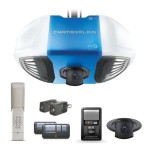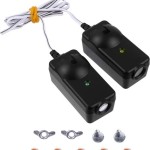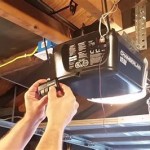Car Door Protector Garage Wall: Safeguarding Your Vehicle and Garage Space
The modern garage often serves as more than just a parking space. It can be a workshop, storage area, or even a home gym. This multi-functional use, combined with the ever-present risk of accidental door dings, necessitates the implementation of effective car door protection strategies, particularly those involving garage wall protectors. These protectors act as a buffer between the car door and the garage wall, mitigating the potential for dents, scratches, and other forms of damage. Choosing the right car door protector for your garage wall involves considering various factors, including material, size, installation method, and overall suitability for your specific needs.
The functionality of a car door protector garage wall is straightforward. It provides a soft, impact-absorbing surface that prevents direct contact between the car door edge and the hard garage wall. This simple concept translates into significant savings over time by reducing the need for costly repairs to vehicle paint and bodywork. Furthermore, it contributes to maintaining the aesthetic appeal and resale value of the vehicle. Beyond the financial and aesthetic benefits, car door protectors enhance the overall safety and usability of the garage space, allowing for easier maneuvering and reducing the risk of accidental injuries.
Understanding the Types of Car Door Protectors
The market offers a diverse range of car door protectors designed for garage walls, each with its own advantages and disadvantages. Understanding these differences is crucial for selecting the most appropriate option for your specific garage environment and vehicle type. These protectors can be broadly categorized based on their material composition and mounting methods.
Foam-based protectors are among the most common and affordable options. These typically consist of dense, closed-cell foam, which provides good impact absorption and is resistant to moisture. Foam protectors are often available in various thicknesses and sizes, allowing for customization to fit different garage layouts and vehicle dimensions. Installation is generally straightforward, typically involving adhesive backing or hook-and-loop fasteners.
Rubber protectors offer superior durability and impact resistance compared to foam. Rubber is a more resilient material, capable of withstanding repeated impacts without significant degradation. These protectors are often textured or ribbed to provide additional grip and prevent slippage. While rubber protectors tend to be more expensive than foam options, their longevity and performance often justify the higher cost. Installation methods can vary, including adhesive, screws, or a combination of both.
Plastic protectors, often made from PVC or similar materials, provide a balance of durability and ease of cleaning. Plastic is resistant to stains and chemicals, making it a suitable choice for garages where spills or exposure to harsh substances is a concern. These protectors are typically rigid or semi-rigid, offering good impact protection but potentially lacking the same level of cushioning as foam or rubber. Installation usually involves screws or adhesive, depending on the specific product design.
Magnetic protectors offer a unique and versatile solution, particularly for garages with metal walls or surfaces. These protectors utilize strong magnets to adhere to the wall, allowing for easy repositioning and removal. Magnetic protectors are ideal for temporary installations or situations where flexibility is desired. However, their effectiveness depends on the presence of a suitable metal surface and the strength of the magnets used.
Key Considerations When Choosing a Car Door Protector
Selecting the right car door protector requires careful consideration of several factors to ensure optimal protection and usability. These factors include the size and layout of the garage, the type and size of the vehicle, the installation method, and the overall durability of the protector.
Garage size and layout are paramount considerations. Measure the available space and identify the areas where car doors are most likely to make contact with the walls. Choose a protector that is appropriately sized to cover these areas effectively. Consider the proximity of other objects in the garage, such as shelves or workbenches, which may limit the available space or require the protector to be shaped or trimmed to fit.
The type and size of the vehicle also play a crucial role in selecting the appropriate protector. Larger vehicles, such as SUVs or trucks, require larger and more robust protectors to provide adequate coverage. Consider the height of the door's impact point and choose a protector that extends sufficiently high enough to protect the entire door edge. Also, consider the door swing radius and ensure that the protector is positioned to intercept the door at the point of maximum extension.
Installation method is another important factor to consider. Adhesive-backed protectors are easy to install but may not be suitable for all wall surfaces. Screws provide a more secure and permanent installation but require drilling and may damage the wall. Magnetic protectors offer the most flexibility but are limited to metal surfaces. Choose an installation method that is appropriate for the wall material and your level of comfort with DIY projects.
Durability is a key consideration, especially for protectors that will be subjected to frequent use or harsh conditions. Choose a protector made from a durable material that can withstand repeated impacts without tearing, cracking, or deteriorating. Consider the protector's resistance to moisture, chemicals, and UV radiation, especially if the garage is unheated or exposed to direct sunlight. Reading reviews and comparing product specifications can help assess the durability of different options.
Installation and Maintenance of Car Door Protectors
Proper installation is critical to ensuring the effectiveness and longevity of car door protectors. The installation process typically involves cleaning the wall surface, marking the desired location of the protector, and attaching the protector using adhesive, screws, or magnets, depending on the chosen method. Regular maintenance, such as cleaning and inspection, is also important to maintain the protector's performance and appearance.
Before installing the protector, thoroughly clean the wall surface to remove any dirt, dust, or grease. This will ensure proper adhesion of the adhesive or prevent slippage of magnetic protectors. Use a mild detergent and water to clean the surface, and then dry it thoroughly with a clean cloth. For porous surfaces, such as concrete or brick, consider applying a primer or sealant to improve adhesion.
Carefully mark the desired location of the protector using a level and a measuring tape. Ensure that the protector is positioned to effectively intercept the car door at the point of maximum extension. Consider the height and width of the door and the potential for movement or shifting during use. Use a pencil or marker to clearly outline the protector's position on the wall.
When installing adhesive-backed protectors, peel off the protective backing and carefully align the protector with the marked outline. Press firmly along the entire surface to ensure proper adhesion. For screw-mounted protectors, pre-drill pilot holes at the marked locations and then screw the protector into the wall. Use appropriate screws for the wall material and ensure that they are securely tightened. For magnetic protectors, simply position the protector on the metal surface and ensure that the magnets are securely attached.
Regular maintenance is essential for maintaining the protector's performance and extending its lifespan. Periodically clean the protector with a mild detergent and water to remove any dirt, dust, or grime. Inspect the protector for any signs of damage, such as tears, cracks, or loose fasteners. Replace the protector if it is significantly damaged or no longer providing adequate protection.
In conclusion, car door protectors for garage walls represent a simple yet effective solution for safeguarding your vehicle and garage space. By carefully considering the various types of protectors available, key factors such as garage size, vehicle type, and installation method, and implementing proper installation and maintenance practices, it is possible to significantly reduce the risk of accidental door dings and maintain the value and appearance of your vehicle and garage.

Park Smart Wall Guard Clear 20005

Garage Wall Protector

Car Door Wall Guard

Garage Wall Protector

Garage Wall Protector 2pack 4pack Car Door Bumper Guard For Ebay

Weathertech Garage Wall Protector

Wall Bumper Pad For Garage Shop Dentgoalie

Park Smart Garage Wall Guard Bumper

4x Garage Wall Protector Car Door Bumper Guard Safety Eva Pads

Have A Question About Maxsa Car Door Bumper Guards And Garage Wall Protector Set Of 2 Pg 1 The Home
See Also








